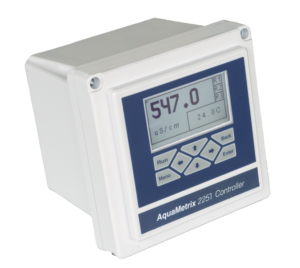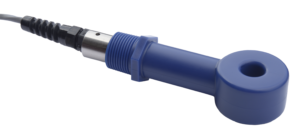
The New AM-2251 Controller Turns Any Toroidal Sensor Into a Super Toroidal
Toroidal sensors are the heavyweights of the conductivity world. Also known as non-contacting or electrodeless, their sensing elements are encased in a hard polymer, so they are almost impossible to foul. They can measure an astonishing range of greater than two thousand to one—typically 100 to 500,000 µS/cm (or greater).
They have only one drawback: That 100 µS/cm lower limit disqualifies them from measuring anything lower, which is just about anything purer than tap water. The inherent principle of operation of the toroidal sensor makes it impossible to change this limitation: There are two parallel windings in a toroidal probe. Current driven through the primary winding (“drive”) induces a magnetic field, which drives ions through a secondary winding (“sense”). The sense winding operates like the drive winding in reverse. The moving ions induces a magnetic field, which, in turn, drives a current in the winding that can be measured. The induced current is proportional to the ion concentration and, hence, the conductivity.
The multiple couplings between the drive current, magnetic field, induced ion current, secondary magnetic field and current render the sensor insensitive to low ion concentrations. In addition, magnetic fields induce different responses at the same field depending on its change. The so-called “hysteresis” will result in measurement error.
The new AM-2251 controller drives a toroidal probe using a patented circuit that is radically different. Instead of the sense circuit being driven indirectly by the drive circuit it contains a feedback circuit that constantly maintains the output of the sense winding near zero. This both increases the sensitivity of the circuit and eliminates errors caused by the hysteresis of the magnetic coupling. The result is a range that we have tested with the AquaMetrix ES1 Toroidal sensor down to 3 µS/cm. The upper limit remains at approximately 400,000 µS/cm though it can go much higher with a higher cell constant probe.
The graph, below, of dissolved NaCl conductivity as a function of concentration shows just how stable and linear the new design is. The graph is logarithmic on both axes to fit data between 10 and 100,000 µS/cm. The output is actually linear. It rolls over at the high end because NaCl conductivity itself rolls over. The limits of NaCl conductivity prevents us from showing, on this graph, the upper measurement range of the AM-2251 and AM-ES1 combination.

The best part of the new controller design is that it will work with ANY toroidal sensor—not just our own AM-ES1. Toroidal probes vary in the ratio of the drive windings to sense windings but a menu option in the AM-2251 allows the user to input the ratio. It also allows for easy calibration of as many as 16 points to accurately measure the full range of salts, acids and bases. The AM-2251 is the only controller on the market that uses this innovative circuit but costs no more than a traditional toroidal controller. It can also be used with our new AM-CDO dissolved oxygen probe or any pH/ORP probe.
The newly redesigned ES1 probe features one of the lowest cell constants on the market (1.5). This is four times lower than the most commonly sold toroidal probes. It is encased in glass-filled polypropylene so that it can resist the harsh environments in which these sensors are commonly used.
Why should anyone care about a conductivity analyzer that can span a whopping range of greater than 100,000 to 1?
- For applications that must sense a large change in conductivity, typically filtration systems, one sensor measures both extremes (before and after filtration).
- Instead of specifying the cell constant for each new application you can now just order ONE sensor and know that it will work (with the exception of ultra-pure water for semiconductor manufacturing). For distributors or high-volume users, it means just stocking one sensor.
- For industrial applications requiring a non-fouling probe (e.g. wastewater, pulp-and-paper, dairy, beverage and plating) the probe delivers superior performance at no additional cost.
The AM-2251 controller uses the patented toroidal conductivity circuit. It can also be used with any pH or ORP probe as well the new AM-CDO dissolved oxygen probe. The new AM-ES1 toroidal probe has the lowest cell constant on the market, enabling it to reach conductivity levels as low 3 µS/cm when used with the AM-2251 controller.


Call Sona Toutounjian at 978-309-0707 or email him at stoutounjian@wateranalytics.net.

